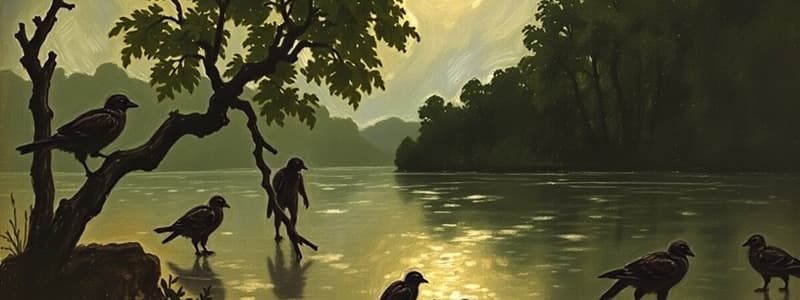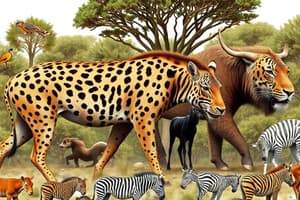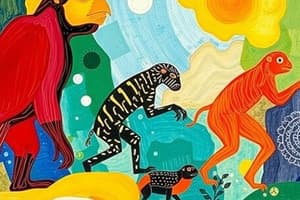Podcast
Questions and Answers
Which mechanism of biological evolution is primarily responsible for the survival of individuals best adapted to their environment?
Which mechanism of biological evolution is primarily responsible for the survival of individuals best adapted to their environment?
- Genetic drift
- Gene flow
- Sexual selection
- Natural selection (correct)
What are the three pillars of natural selection as proposed by Darwin?
What are the three pillars of natural selection as proposed by Darwin?
- Reproduction, variation, heredity
- Survival, competition, diversity
- Competition, variation, heritability (correct)
- Adaptation, selection, evolution
What phenomenon occurs when certain traits appear to have no direct benefit for survival but enhance mating opportunities?
What phenomenon occurs when certain traits appear to have no direct benefit for survival but enhance mating opportunities?
- Natural selection
- Gene flow
- Genetic drift
- Sexual selection (correct)
Which statement best describes genetic variation?
Which statement best describes genetic variation?
What role do genes play in the characteristics of organisms?
What role do genes play in the characteristics of organisms?
What is a common misconception regarding population growth in the context of natural selection?
What is a common misconception regarding population growth in the context of natural selection?
In the context of biological evolution, what does heritability refer to?
In the context of biological evolution, what does heritability refer to?
Which of the following statements is true regarding the challenges Darwin and Wallace faced in explaining evolutionary change?
Which of the following statements is true regarding the challenges Darwin and Wallace faced in explaining evolutionary change?
What is considered the unit of selection in biological evolution?
What is considered the unit of selection in biological evolution?
Which type of sexual selection involves female choice and preferential mate selection?
Which type of sexual selection involves female choice and preferential mate selection?
How long ago did the cognitive revolution occur in human evolution?
How long ago did the cognitive revolution occur in human evolution?
What does evolutionary psychology NOT aim to be?
What does evolutionary psychology NOT aim to be?
Which of the following is NOT one of the five principles of evolutionary psychology?
Which of the following is NOT one of the five principles of evolutionary psychology?
What is an example of a mismatch arising from the environment of evolutionary adaptiveness (EEA)?
What is an example of a mismatch arising from the environment of evolutionary adaptiveness (EEA)?
Which behavioral adaptation can be explained by understanding the aggression's evolutionary predictions?
Which behavioral adaptation can be explained by understanding the aggression's evolutionary predictions?
Which characteristic pertains to the life of Homo sapiens as hunter-gatherers?
Which characteristic pertains to the life of Homo sapiens as hunter-gatherers?
What factor greatly influences behavior according to evolutionary psychology?
What factor greatly influences behavior according to evolutionary psychology?
Which of the following does evolutionary psychology hypothesize about the mind?
Which of the following does evolutionary psychology hypothesize about the mind?
What type of resource acquisition may lead to aggression as proposed in evolutionary psychology?
What type of resource acquisition may lead to aggression as proposed in evolutionary psychology?
What aspect of human physiology is mentioned as being influenced by genetic evolution?
What aspect of human physiology is mentioned as being influenced by genetic evolution?
Which of these evolutionary predictions relates to social hierarchies?
Which of these evolutionary predictions relates to social hierarchies?
What is the primary focus of comparative evolutionary psychology?
What is the primary focus of comparative evolutionary psychology?
What does parental investment theory suggest about mate selection?
What does parental investment theory suggest about mate selection?
Which type of selection is characterized by competition among the same sex for access to mates?
Which type of selection is characterized by competition among the same sex for access to mates?
What is a key hypothesis regarding mate preferences related to MHC compatibility?
What is a key hypothesis regarding mate preferences related to MHC compatibility?
What assumption is made about traits that emerge earlier in development?
What assumption is made about traits that emerge earlier in development?
Which theory posits that females will choose mates based on the resources they can provide?
Which theory posits that females will choose mates based on the resources they can provide?
What major limitation is addressed by comparative evolutionary psychology?
What major limitation is addressed by comparative evolutionary psychology?
Which statement best describes the averageness hypothesis?
Which statement best describes the averageness hypothesis?
How does the developmental perspective influence the understanding of behavior?
How does the developmental perspective influence the understanding of behavior?
What does social psychology suggest about gendered mate preferences?
What does social psychology suggest about gendered mate preferences?
Which of the following is NOT a methodological perspective combined in the comparative approach?
Which of the following is NOT a methodological perspective combined in the comparative approach?
What is the primary focus of sexual selection as described in the content?
What is the primary focus of sexual selection as described in the content?
Which approach argues that the sex with higher parental investment will be more selective in mate choice?
Which approach argues that the sex with higher parental investment will be more selective in mate choice?
The cultural intelligence hypothesis suggests that humans have evolved what type of skills?
The cultural intelligence hypothesis suggests that humans have evolved what type of skills?
Flashcards
Natural Selection
Natural Selection
Organisms better adapted to their environment are more likely to survive and reproduce, passing on their advantageous traits.
Sexual Selection
Sexual Selection
Traits that enhance mating success, even if not directly related to survival, can evolve through sexual selection.
Genetic Drift
Genetic Drift
Random changes in allele frequencies in a population, especially pronounced in small populations.
Gene Flow
Gene Flow
Signup and view all the flashcards
Competition
Competition
Signup and view all the flashcards
Variation
Variation
Signup and view all the flashcards
Alleles
Alleles
Signup and view all the flashcards
Heritability
Heritability
Signup and view all the flashcards
Sexual Reproduction
Sexual Reproduction
Signup and view all the flashcards
Mutation
Mutation
Signup and view all the flashcards
Selfish Gene
Selfish Gene
Signup and view all the flashcards
Biological Fitness
Biological Fitness
Signup and view all the flashcards
Intersexual Selection
Intersexual Selection
Signup and view all the flashcards
Intrasexual Selection
Intrasexual Selection
Signup and view all the flashcards
Evolutionary Psychology (EP)
Evolutionary Psychology (EP)
Signup and view all the flashcards
Environment of Evolutionary Adaptedness (EEA)
Environment of Evolutionary Adaptedness (EEA)
Signup and view all the flashcards
Mismatch Example
Mismatch Example
Signup and view all the flashcards
Homo Sapiens
Homo Sapiens
Signup and view all the flashcards
Cognitive Revolution
Cognitive Revolution
Signup and view all the flashcards
Industrial Revolution
Industrial Revolution
Signup and view all the flashcards
Digital Revolution
Digital Revolution
Signup and view all the flashcards
Selective Breeding
Selective Breeding
Signup and view all the flashcards
Comparative Evolutionary Psychology
Comparative Evolutionary Psychology
Signup and view all the flashcards
Parental Investment Theory
Parental Investment Theory
Signup and view all the flashcards
Mate Preferences (Evolutionary Approach)
Mate Preferences (Evolutionary Approach)
Signup and view all the flashcards
MHC Compatibility
MHC Compatibility
Signup and view all the flashcards
Averageness Hypothesis
Averageness Hypothesis
Signup and view all the flashcards
Developmental Approach (Comparative EP)
Developmental Approach (Comparative EP)
Signup and view all the flashcards
Cross-Cultural Approach (Comparative EP)
Cross-Cultural Approach (Comparative EP)
Signup and view all the flashcards
Cross-Species Approach (Comparative EP)
Cross-Species Approach (Comparative EP)
Signup and view all the flashcards
Evolutionary Psychology (vs. Social Psychology)
Evolutionary Psychology (vs. Social Psychology)
Signup and view all the flashcards
Genetic Determinism
Genetic Determinism
Signup and view all the flashcards
Non-Genetic explanations
Non-Genetic explanations
Signup and view all the flashcards
Study Notes
Diversity of Life
- Earth is home to approximately 8.7 million species.
- Explaining this vast diversity with a coherent theory has been a challenge.
- Debates on evolutionary theories continue.
Mechanisms of Evolution
- Five key mechanisms drive biological evolution:
- Natural selection
- Sexual selection
- Genetic drift
- Gene flow
- Mutation
Observations Before Darwin & Wallace
- Change occurs over time.
- Traits have a purpose.
Darwin & Wallace's Explanatory Challenge
- Why do changes occur?
- How do new species emerge?
- What is the function of traits?
The Origin of Species (Darwin 1859)
- Three pillars of natural selection:
- Competition: Unlimited resources lead to exponential population growth, creating a struggle for existence.
- Variation: Individuals vary in their ability to compete. Individuals with advantageous variations are selected. The best-adapted individuals are most likely to survive.
- Heritability: Variation is inherited. Differential reproductive success leads to the evolution of populations.
Natural Selection Scrutinized
- Population growth: Populations indeed grow exponentially.
- Sufficient time: Evolution has occurred over significant time spans.
- Heritability of variation: Variation is passed on to offspring.
- Sexual dimorphism: Some adaptations, seemingly non-survival-related, are advantageous for mating or reproduction.
Genes
-
Genes influence physical appearance and bodily functions.
-
Genes contain instructions needed to produce proteins.
-
Proteins structure the body and support processes.
-
Genes reside on DNA strands (deoxyribonucleic acid).
-
Gregor Mendel (1865): Organisms inherit two alleles (one from each parent).
-
DNA replicates and is passed to offspring.
-
Genotype: Genetic makeup.
-
Phenotype: Observable traits.
-
Sources of genetic variation: Sexual reproduction, mutation, genetic drift, and gene flow.
The Selfish Gene
- The gene is the fundamental unit of selection in evolution (not the individual or trait).
- Genes are inherently self-serving.
- Biological fitness is measured by the number of gene copies passed on.
Sexual Selection
- Intersexual selection: Preferential mate choice, often driven by female selection and gametic investment.
- Intrasexual selection: Competition between same-sex individuals for access to mates (e.g., status, combat, resource control).
Evolution of the Human Species
- Hunter-gatherer lifestyle: 200,000 years ago to now, lived in groups, likely had egalitarian social structures, and displayed a division of labor.
- Cognitive revolution: 70,000 years ago
- Industrial revolution: 200 years ago
- Digital revolution: 20 years ago
From Evolution to Human Behavior
- Evolution, genes, psychology, cognition, behavior, learning, and culture are interconnected.
- Physiology and behavior are gene-dependent.
Evolutionary Psychology (EP)
- An approach to understanding the design of the human mind (not a field of study).
- The human mind is a set of information-processing machines designed by natural selection to address problems faced in the hunter-gatherer era.
Five Principles of Evolutionary Psychology
- Physical system: The brain operates according to physical laws.
- Adaptive problems: Neural circuits evolved to address ancestral problems.
- Hidden processes: Much of mental activity occurs unconsciously.
- Specialized circuits: Different circuits solve specific adaptive problems.
- Stone Age mind: Modern behavior is rooted in ancestral solutions.
Environment of Evolutionary Adaptedness (EEA)
- Mismatch example 1 (Fear): Fears of EEA threats (e.g., snakes) are more substantial than modern (e.g., cars).
- Mismatch example 2 (Diet): Modern diets differ from ancestral needs, leading to health issues due to excessive sugar and fat consumption.
Criticism of Evolutionary Psychology
- Methodology: Backwards inferences, "just-so stories," uncertain EEA pressures.
- Interpretation: Concerns about eugenics, feminism, and other potential biases.
- Non-adaptive explanations: Alternative explanations for behaviors.
Comparative Evolutionary Psychology
- Addresses EP's limitations by comparing humans to other species to understand the origins of behavior.
- Three perspectives:
- Developmental: Early emergence traits vs learned traits
- Phylogenetic: Traits in related species.
- Cross-cultural: Trait variations across groups.
Intersexual Selection
- Natural selection prioritises survival traits.
- Sexual selection prioritises mating success.
Parasite Theory
- Parasites are major mortality factors and lead to attractive traits (signal a strong immune system).
Averageness Hypothesis
- Average/composite faces are rated as more attractive.
Parental Investment Theory (Trivers 1972)
- Parental investment is the expenditure on offspring for survival and reproductive success.
- Females invest more than males due to larger gametes and pregnancy/childbirth.
- Sex with greater investment is more selective in choosing mates.
- Less-investing sex competes for mates.
Mate Preferences (Evolutionary Approach)
- Buss (1989): Cross-cultural study of mate preferences.
- Sex differences in preferences emerge, with males valuing reproductive capacity and females valuing resource acquisition.
- There are noted intra-sexual variations.
Mate Preferences - Face and Odor Preferences
- Masculinity preferences in women's choices are complex.
- MHC (Major Histocompatibility Complex): Genes related to immunity and mate choice in many species (humans prefer MHC dissimilar mates).
Sexual social roles
- Evolutionary psychology vs. social psychology on sex differences
- Social psychology considers social structure's significant influence. individuals seek mates suitable for social roles.
Gender Equality
- Gender differences in mate preferences decline with greater gender equality.
Studying That Suits You
Use AI to generate personalized quizzes and flashcards to suit your learning preferences.




